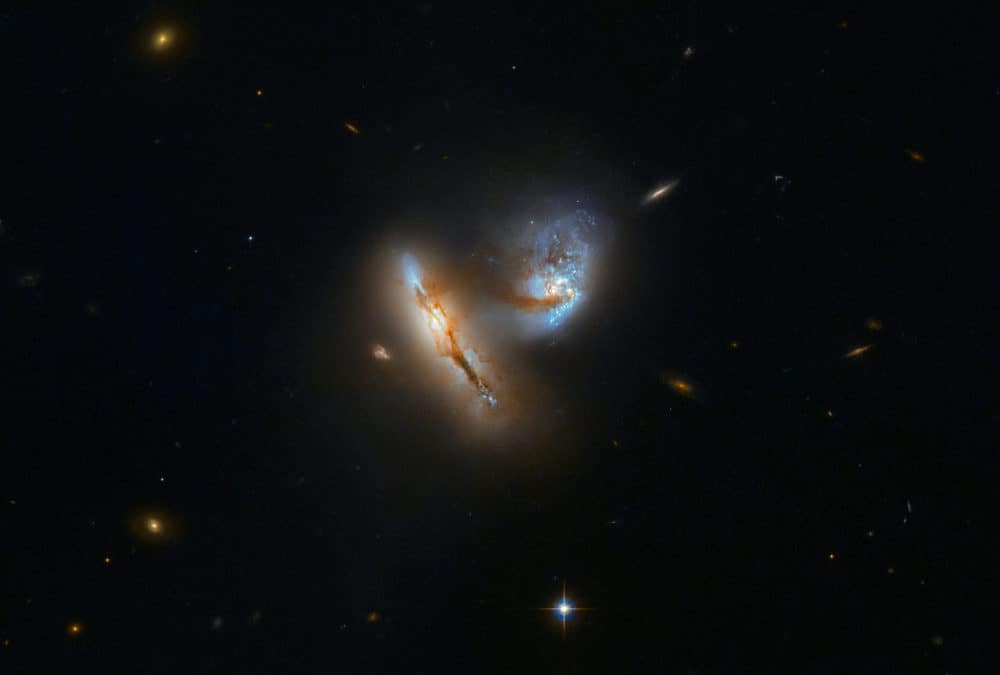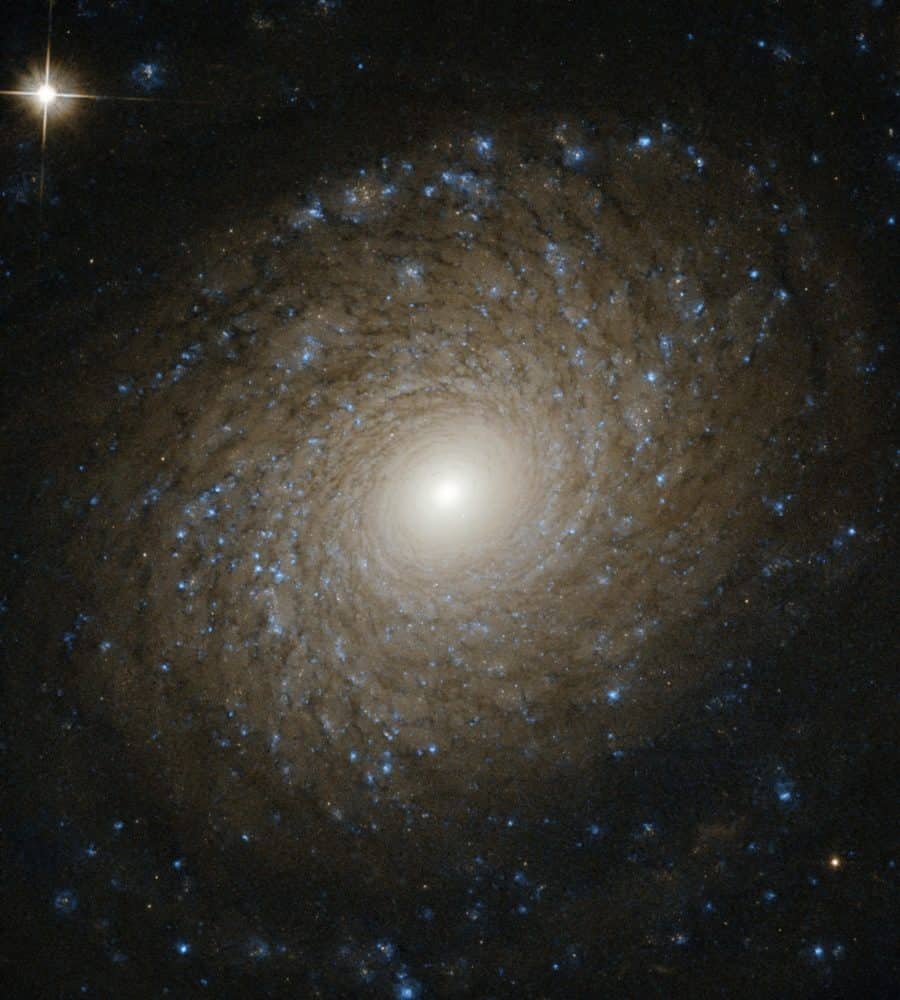Blog
Cygnus OB2 is an OB association that is home to some of the most massive and most luminous stars known, including suspected Luminous blue variable Cyg OB2 #12. It also includes one of the largest known stars, NML Cygni. The region is embedded within a wider one of star formation known as Cygnus X, which is one of the most luminous objects in the sky at radio wavelengths. The region is approximately 1,400 parsecs from Earth in the constellation of Cygnus.
The young cluster is one of the largest known and the largest in the northern hemisphere with some authors formerly classifying it as a young globular cluster similar to those in the Large Magellanic Cloud. Today, however, it is considered a massive, low-density stellar association.
Although it is over ten times more massive than the Orion Nebula, which is easily seen with the naked eye, Cygnus OB2 is hidden behind a massive dust cloud known as the Cygnus Rift, which obscures many of the stars in it. This means that despite its large size, it is hard to determine its actual properties. The estimated number of massive stars range from 50 to 100 of spectral type Oand its total mass having been calculated as (4–10)×104 or 3×104 solar masses according to other investigations.
Despite this, recent surveys ranging from radio to X-ray wavelengths have observed the region to great depths to gain a better understanding of how the processes of star and planet formation occur on such a large scale. These studies include observations with the Chandra X-ray Observatory, Spitzer Space Telescope, the Herschel Space Observatory and the Gran Telescopio Canarias. As for recent observations the final stages of the process of photoablation is taking place, where the biggest stars formed and cleared the ambient material from the region.
more...
Patrick Bruce Metheny (/məˈθiːni/ mə-THEE-nee; born August 12, 1954) is an American jazz guitarist and composer.
He is the leader of the Pat Metheny Group and is also involved in duets, solo works, and other side projects. His style incorporates elements of progressive and contemporary jazz, Latin jazz, and jazz fusion. Metheny has three gold albums and 20 Grammy Awards and is the only person to win Grammys in 10 categories. He is the brother of jazz flugelhornist Mike Metheny.
Metheny was born in Lee’s Summit, Missouri. His father Dave played trumpet, his mother Lois sang, and his maternal grandfather Delmar was a professional trumpeter. Metheny’s first instrument was trumpet, which he was taught by his brother, Mike. His brother, father, and grandfather played trios together at home. His parents were fans of Glenn Miller and swing music. They took Metheny to concerts to hear Clark Terry and Doc Severinsen, but they had little respect for guitar. Metheny’s interest in guitar increased around 1964 when he saw the Beatles perform on TV. For his 12th birthday, his parents allowed him to buy a guitar, which was a Gibson ES-140 3/4.
Metheny’s life changed after hearing the album Four & More by Miles Davis. Soon after, he was captivated by Wes Montgomery‘s album Smokin’ at the Half Note which was released in 1965. He cites the Beatles, Miles Davis, and Wes Montgomery as having the biggest impact on his music.
When he was 15, he won a scholarship from Down Beat magazine to a one-week jazz camp where he was mentored by guitarist Attila Zoller, who then invited Metheny to New York City to see guitarist Jim Hall and bassist Ron Carter.
https://www.youtube.com/watch?v=EciWe9eqViQ
more...Porter Wayne Wagoner (August 12, 1927 – October 28, 2007) was an American country music singer known for his flashy Nudie and Manuel suits and blond pompadour.
In 1967, he introduced singer Dolly Parton on his television show, and they were a well-known vocal duo throughout the late 1960s and early 1970s.
Known as Mr. Grand Ole Opry, Wagoner charted 81 singles from 1954–1983. He was elected to the Country Music Hall of Fame in 2002. Wagoner was born in West Plains, Missouri, the son of Bertha May (née Bridges) and Charles E. Wagoner, a farmer. His first band, the Blue Ridge Boys, performed on radio station KWPM-AM from a butcher shop in his native West Plains, Missouri, where Wagoner cut meat. In 1951, he was hired by Si Siman as a performer on KWTO in Springfield, Missouri. This led to a contract with RCA Victor.
https://www.youtube.com/watch?v=uQJCPyGq2sI
Joseph Charles “Joe” Jones (August 12, 1926 – November 27, 2005) was an American R&B singer, songwriter and arranger, who was born in New Orleans, Louisiana. Jones is also generally credited with discovering the Dixie Cups. He also worked with B.B. King. As a singer, Jones had his greatest hit in the form of the Top Five 1960 R&B hit “You Talk Too Much“, which also reached #3 on the pop chart. Jones served in the U.S. Navy, where he played piano in a band, before studying music at the Juilliard Conservatory of Music. He formed a band, Joe Jones and his Atomic Rebops, in the late 1940s; band members played on Roy Brown‘s 1947 hit “Good Rocking Tonight“. He was expelled from the New Orleans local chapter of the American Federation of Musicians for attempting to set up a rival organization but was later reinstated.
He became a valet, then pianist and arranger for B.B. King, and recorded his first solo single, “Adam Bit the Apple”, for Capitol Records in 1954. He also discovered Shirley and Lee, whose recording of “Let the Good Times Roll” became a hit in 1956. In 1960, a re-recording of a song he had first recorded in 1958, “You Talk Too Much” on Ric Records, became a national success, but his subsequent releases were less successful.
Jones claimed to have composed many songs, including the song “Iko Iko.” Although his assertions were originally successful, a federal jury and then Court of Appeals ruled that Jones did not write “Iko Iko,” that his claims were fraudulent, and that the true writers were the band he managed, the Dixie Cups (the true original recording of this song had been released as Checker 787 by New Orleans singer and pianist Sugar Boy Crawford and his Cane Cutters in late 1953). The band hired music attorney Oren Warshavsky, who had previously won a case demonstrating that Jones falsely professed ownership of another Mardi Gras classic song, “It Ain’t My Fault.” Jones also failed in his bid to declare title (though not as an author) to yet another Mardi Gras classic song, “Carnival Time.” He also recorded the original “California Sun” on Roulette Records in 1961, which was made a hit by the Rivieras in 1963.
more...Finland
more...Visible in the constellation of Leo Minor, NGC 3432 is located some 45 million light-years away from Earth.Also known as LEDA 32643 and UGC 5986, the galaxy was discovered by British astronomer William Herschel on March 19, 1787.Its distinctive shape is due to the ongoing gravitational interaction with UGC 5983, a dwarf galaxy to the southwest of NGC 3432.The interacting duo is included in Arp’s catalogue with the label Arp 206.“It turns out that we see NGC 3432 orientated directly edge-on to us from our vantage point here on Earth,” Hubble astronomers said.“The galaxy’s spiral arms and bright core are hidden, and we instead see the thin strip of its very outer reaches.”“Dark bands of cosmic dust, patches of varying brightness, and pink regions of star formation help with making out the true shape of NGC 3432 — but it’s still somewhat of a challenge!”“Because observatories such as Hubble have seen spiral galaxies at every kind of orientation, we can tell when we happen to have caught one from the side.”In May 2000, an unusual and very luminous stellar explosion, named SN 2000ch, was spotted in NGC 3432 by astronomers from the Lick Observatory Supernova Search.
more...Bill Heid (born August 11, 1948) is an American soul jazz and hard bop jazz pianist and organist, born in Pittsburgh, Pennsylvania, United States, probably better known for his work with musicians such as Koko Taylor, Henry Johnson and Fenton Robinson, amongst others.
more...Manabendra Mukhopadhyay (Bengali: মানবেন্দ্র মুখোপাধ্যায়) was an Indian singer and music composer. Manabendra was born in Kolkata on 11 August 1931. His father’s name was Atulchandra Mukhopadhay. It is considered that during the 1950s, 1960s and 1970s the Bengali modern songs reached its peak of excellence and that period is usually called the “Golden age of Bengali Adhunik Songs”. At that time Bengal had a unique mix of singers which inspired composers and lyricists to create innumerable treasure of creative music. Each singer had his own inimitable style and compositions were made to match their individual ability. Bengali non-film modern songs were in fact was as popular, if not more, than film songs which also reached a level of popularity in the 1950s and 1960s.
Coming to limelight in the early 1950s Manabendra was an innovative and stylish singer who had a strong foundation in Indian classical music. With his distinctive voice, Manabendra was an instant hit with the audience. demonstrating great talent also as a composer, using the lyrics and melody of a song with good effect. At that time Bengali modern song world had the presence of some outstanding performers like Dhananjay Bhattacharya, Manna Dey, Satinath Mukherjee, Akhil Bandhu Ghosh, Hemanta Mukhopadhyay to name a few.
https://www.youtube.com/watch?v=mYdTVwVtla8&t=591s
more...John Arthur “Johnny” Van Derrick (born August 11, 1926 in Ealing , † May 15, 1995 in Denham , Buckinghamshire ) was a British jazz violinist who also worked as a studio musician in the field of pop music .
Van Derrick was led to music by his father, a Dutch cornetist. He attended the Conservatory in Brussels and had classical music lessons until the outbreak of World War II. In London, he played during the war first with Louis Mexano’s Accordion Band, before he worked in the merchant marine . In the post-war years, he first played as a trumpeter in dance bands by Maurice Winnick and Lou Preager, eventually he took violin lessons with his mentor Sascha Lasserson and played in the Halle Orchestra, before he worked from then on as a freelance musician. He appeared with Roy Fox and Geraldo and he played in the early 1960s in Diz Disley’s String Quintet, with the first recordings emerged ( At the Jazz Band Ball ), also with Tubby Hayes , Gary Potter and the Jack Togood Swing set . In 1976 he was able to work again after a serious illness.
Also known as KPG 82 and Z 0251.2+1446, this galactic duo is located approximately 424 million light-years away from Earth in the constellation Aries. The two galaxies, called UGC 2369N and UGC 2369S, are interacting, meaning that their mutual gravitational attraction is pulling them closer and closer together and distorting their shapes. In the process, the two galaxies pulled material out into space across the diminishing divide between them. The tenuous bridge of gas, dust, and stars can be seen connecting UGC 2369N and UGC 2369S.
more...
Ian Scott Anderson MBE (born 10 August 1947) is a Scottish-born musician, singer, songwriter and multi-instrumentalist best known for his work as the lead vocalist, flautist and acoustic guitarist of British rock band Jethro Tull. Anderson plays several other musical instruments, including keyboards, bass guitar, bouzouki, balalaika, saxophone, harmonica, and a variety of whistles. His solo work began with the 1983 album Walk into Light, and since then he has released another five works, including the sequel to the Jethro Tull album Thick as a Brick (1972) in 2012, entitled Thick as a Brick 2. Ian Anderson was born in Dunfermline, Fife, Scotland, the youngest of three brothers. His father, James Anderson, ran the RSA Boiler Fluid Company in East Port, Dunfermline. Anderson spent the first part of his childhood in Edinburgh.
In 1963, he formed The Blades from among school friends: Michael Stephens (guitar), John Evan (keyboards), Jeffrey Hammond (bass) and Barriemore Barlow (drums). This was a soul and bluesband, with Anderson on vocals and harmonica – he had yet to take up the flute. They played their first show at the Holy Family Church Hall in North Shore.
In late 1967, Anderson was still holding down a day job, namely cleaning the Ritz Cinema in Luton, including the toilets, in the mornings, “which took me half the day” he said in a later interview. He took an old, chipped urinal from the cinema storeroom and had it for a time after leaving the job. It was not, however, the urinal which “was bolted to the side of John Evan’s Hammond organ on stage” and figured in early 1970s Tull performances.
At this time Anderson abandoned his ambition to play electric guitar, allegedly because he felt he would never be “as good as Eric Clapton“. As he himself tells it in the introduction to the video Nothing Is Easy: Live at the Isle of Wight 1970, he traded his electric guitar in for a flute which, after some weeks of practice, he found he could play fairly well in a rock and blues style. According to the sleeve notes for the first Tull album, This Was (1968), he had been playing the flute only a few months when the album was recorded. His guitar practice did not go to waste either, as he continued to play acoustic guitar, using it as a melodic and rhythmic instrument. As his career progressed, he added soprano saxophone, mandolin, keyboards and other instruments to his arsenal.
His tendency to stand on one leg while playing the flute came about by accident, as he had been inclined to stand on one leg while playing the harmonica, holding the microphone stand for balance. Anderson was known for his famous one-legged flute stance, and was once referred to as a “deranged flamingo” This stance is on many album covers of Jethro Tull. During a long stint at the Marquee Club, a journalist described him, wrongly, as standing on one leg to play the flute, when in fact he was originally playing the harmonica on one leg. He decided to live up to the reputation, albeit with some difficulty. His early attempts are visible in The Rolling Stones Rock and Roll Circus (1968) film appearance of Jethro Tull. This was referenced in the facetious liner notes for Thick as a Brick in a quote about “the one-legged pop flautist, Ian Anderson”.
https://www.youtube.com/watch?v=EsCyC1dZiN8
more...
Gertrude E. “Trudy” Pitts (August 10, 1932 – December 19, 2010) was an American soul jazz keyboardist from Philadelphia, Pennsylvania. She was known primarily for playing the Hammond B3 organ. Trained as a musician and a music educator, Pitts studied at the Philadelphia Musical Academy, Temple University and Juilliard, as well as other institutions. Early work experience included a position as an assistant to the pianist in the Tony Award-winning musical Raisin.
At the end of the musical’s tour, she was encouraged by her husband (who had worked with Shirley Scott as a drummer) to continue developing her repertoire.
In 1967, the Boston Globe printed a piece calling her a rising star and complimented her drawbar variation, vibrato shadings, and bass pedal work. Her husband, William Theodore Carney II (born 1925), aka “Mr. C.”, often joined her on the drums.
Trudy Pitts eventually went on to play with Ben Webster, Gene Ammons, and Sonny Stitt. She recorded four albums for Prestige Records, appearing with Willis Jackson among others. In 1999, a compilation album of several records was released as Legends of Acid Jazz, Trudy Pitts & Pat Martino. Recent festival appearances include the 11th Annual Mary Lou Williams Women in Jazz Festival at the Kennedy Center in Washington, D.C., in May 2006. On September 15, 2006, Pitts was the first jazz artist play a concert on Philadelphia’s Kimmel Center’s 7,000 pipe organ, “taking the medium to a whole new level.
more...Charles H. Israels (born August 10, 1936) is a composer, arranger, and bassist who is best known for his work with the Bill Evans Trio. He has also worked with Billie Holiday, Benny Goodman, Coleman Hawkins, Stan Getz, Herbie Hancock, J. J. Johnson, John Coltrane, and Judy Collins.
Born in New York City, Chuck Israels was raised in a musical family which moved to Cleveland, Ohio when he was 10. His stepfather Mordecai Bauman was a singer who performed extensively with composer Hanns Eisler. He, along with Israels’ mother, Irma Commanday, created a home environment in which music was a part of normal daily activity. Paul Robeson, Pete Seeger, and The Weavers were visitors to the Bauman home. In 1948, the appearance of Louis Armstrong‘s All Stars in a concert series produced by his parents gave him his first opportunity to meet and hear jazz musicians.
more...Arnett Cleophus Cobb (August 10, 1918 – March 24, 1989) was an American jazz tenor saxophonist, sometimes known as the “Wild Man of the Tenor Sax” because of his uninhibited stomping style. Cobb wrote the words and music for the jazz standard “Smooth Sailing” (1951), which Ella Fitzgerald recorded for Decca on her album Lullabies of Birdland. Born in Houston, Texas, he was taught to play piano by his grandmother, and he went on to study violin before taking up tenor saxophone in the high school band. At the age of 15 he joined Louisiana bandleader Frank Davis’s band, doing shows in Houston and throughout Louisiana during the summer. Cobb continued his musical career with the local bands of trumpeter Chester Boone, from 1934 to 1936, and Milt Larkin, from 1936 to 1942 (which included a period on the West Coast with Floyd Ray). Among his bandmates in the Larkin band were Illinois Jacquet, Eddie “Cleanhead” Vinson, Tom Archia, Cedric Haywood, and Wild Bill Davis. Having turned down an offer from Count Basie in 1939, Cobb replaced Jacquet in Lionel Hampton‘s band in 1942, staying with Hampton until 1947. Cobb’s featured solo on Hampton’s theme song “Flying Home No. 2” generated much excitement, his blasting style earning him the label “Wild Man of the Tenor Sax”.
more...Zimbabwe
more...NGC 2985 is a spiral galaxy located in the constellation Ursa Major. It is located at a distance of circa 70 million light years from Earth, which, given its apparent dimensions, means that NGC 2985 is about 95,000 light years across. It was discovered by William Herschel on April 3, 1785.
The galaxy is seen with an inclination of 37 degrees. The galaxy has a bright nucleus from which emanate multiple tightly wound spiral fragments.Numerous blue knots are visible at the galactic disk. At the outer part of the galaxy lies a massive spiral arm that forms a pseudoring that encircles the galaxy. The inner part of the galaxy, where active star formation has been observed, has been found to be unstable, contrary to the outer stable one. It has been suggested that the presence of molecular clouds accounts for the instability of the region.
The nucleus of NGC 2985 is active, and based on its spectrum has been categorised as a LINER. The most accepted theory for the activity source is the presence of an accretion disk around a supermassive black hole.
more...More Posts
- Beryl McBurnie
- World Music with Sunny Jain
- Daily Roots with Justin Hinds
- Dia de los Muertos 2021
- The Cozmos with NGC 6984
- Lyle Lovett
- Rick Grech
- Little Johnny Jones
- Lou Donaldson
- World Fusion with Shanren
- Daily Roots with Abdul Sabuza & Soul Syndicate Band
- Happy Halloween 2021
- The Cozmos with NGC 2237
- Ali Farka” Touré
- Tom Paxton
- World Music with LISTWAR ZANSET
- Booker Ervin
- Illinois Jaquet
- Daily Roots with The Soul Syndicate with Earl Zero
- The Cozmos with Rorschach Aurora



